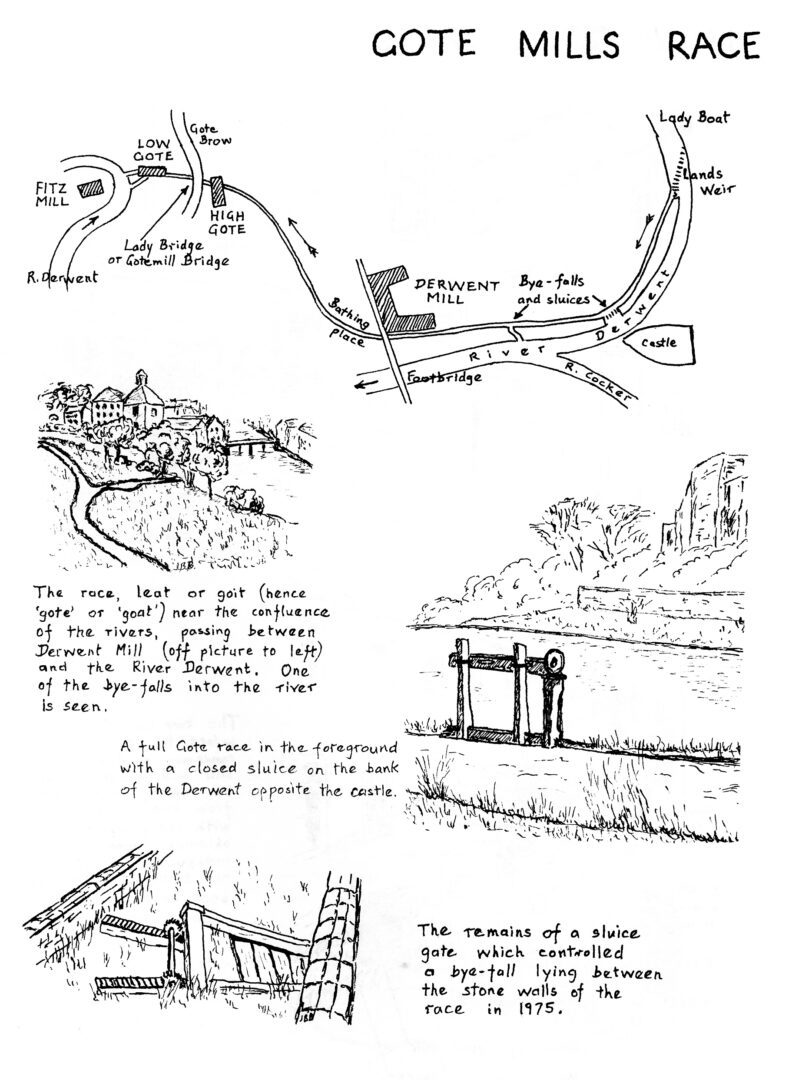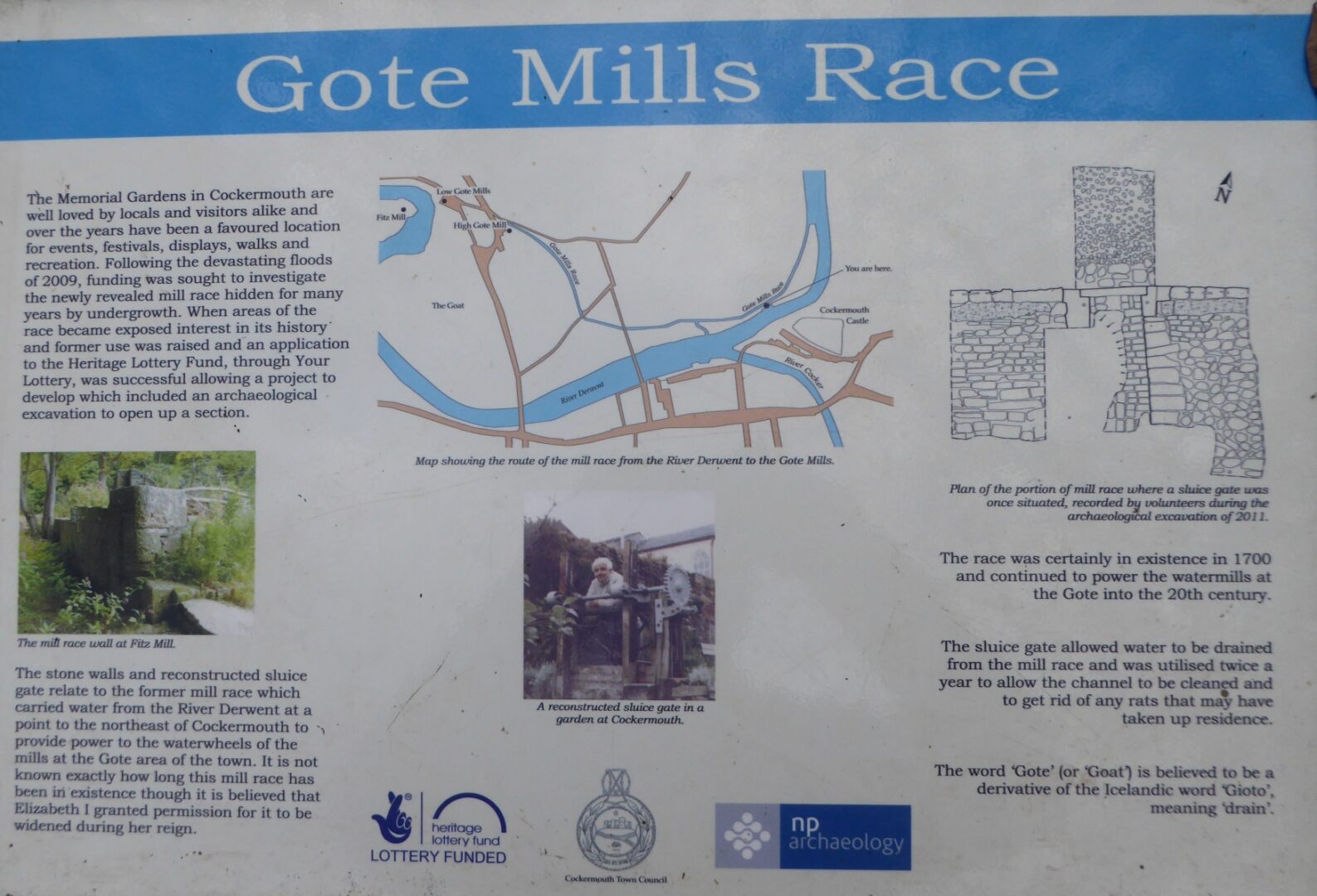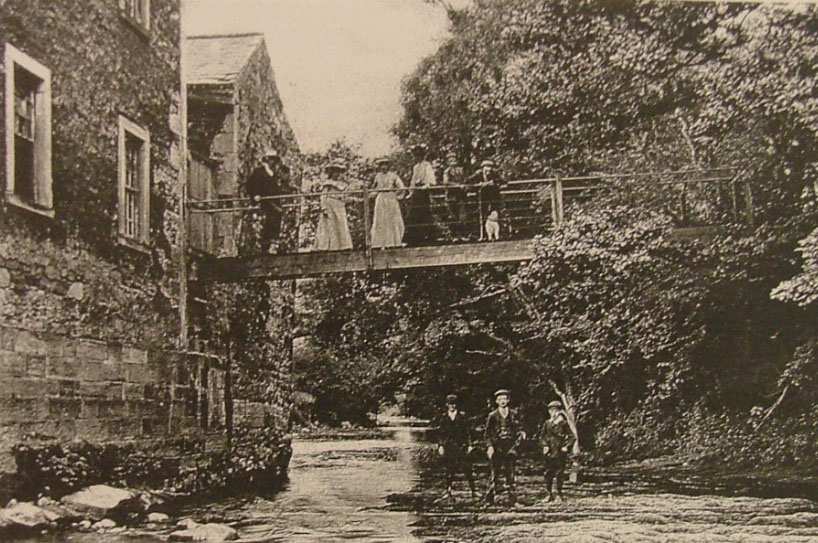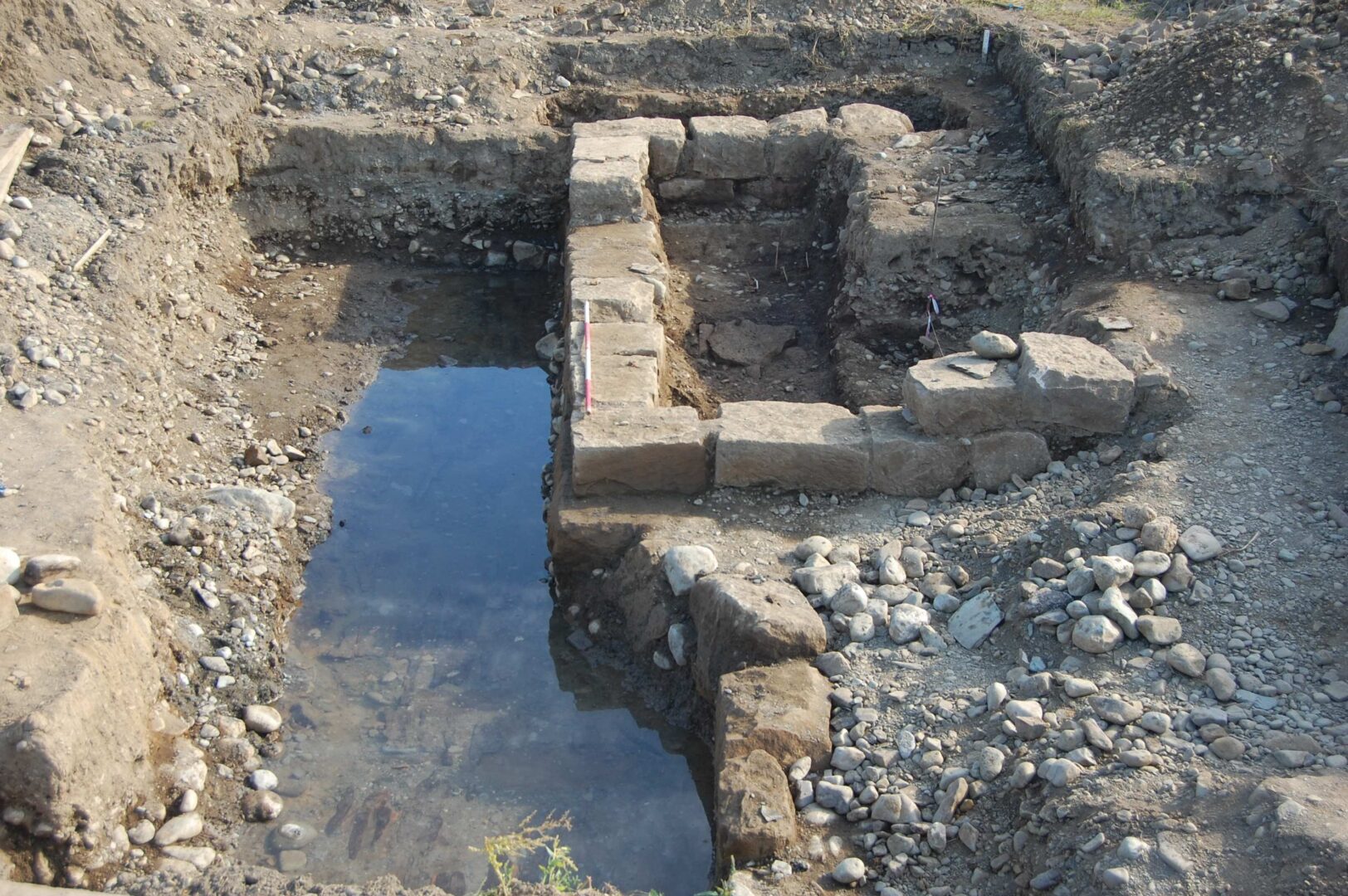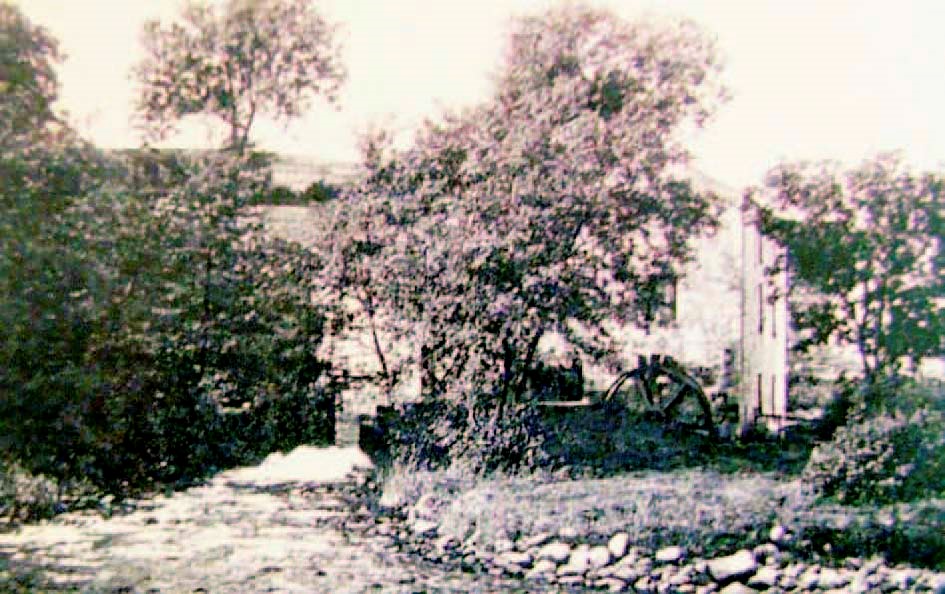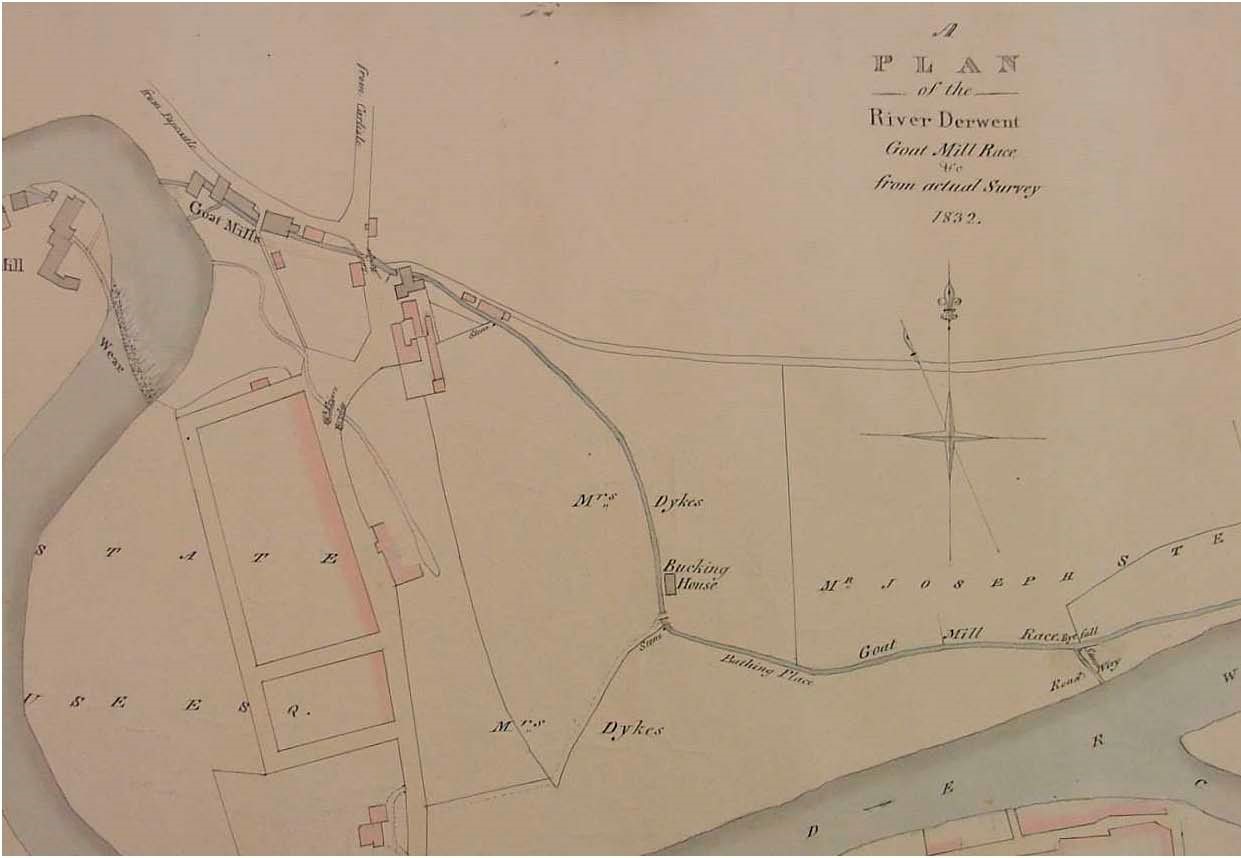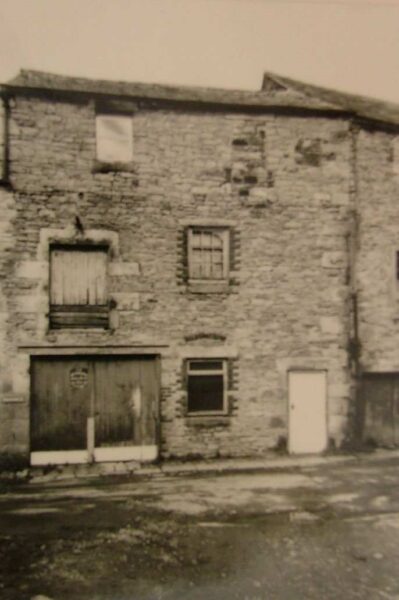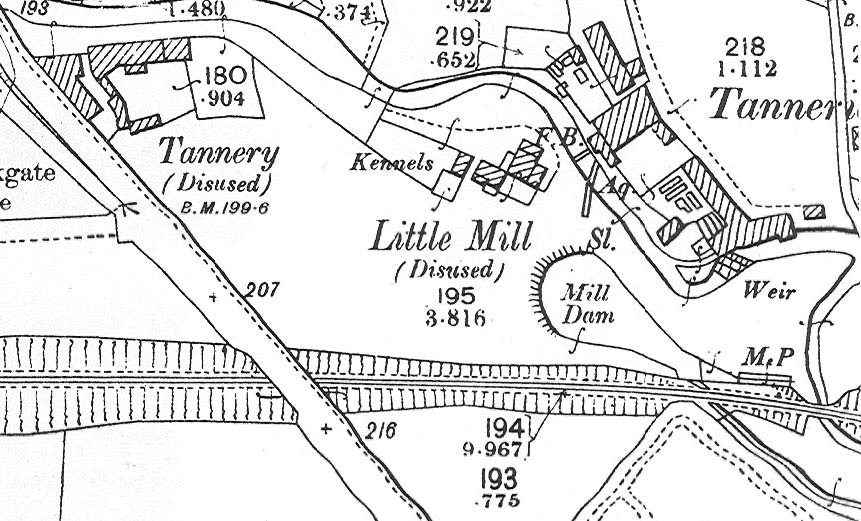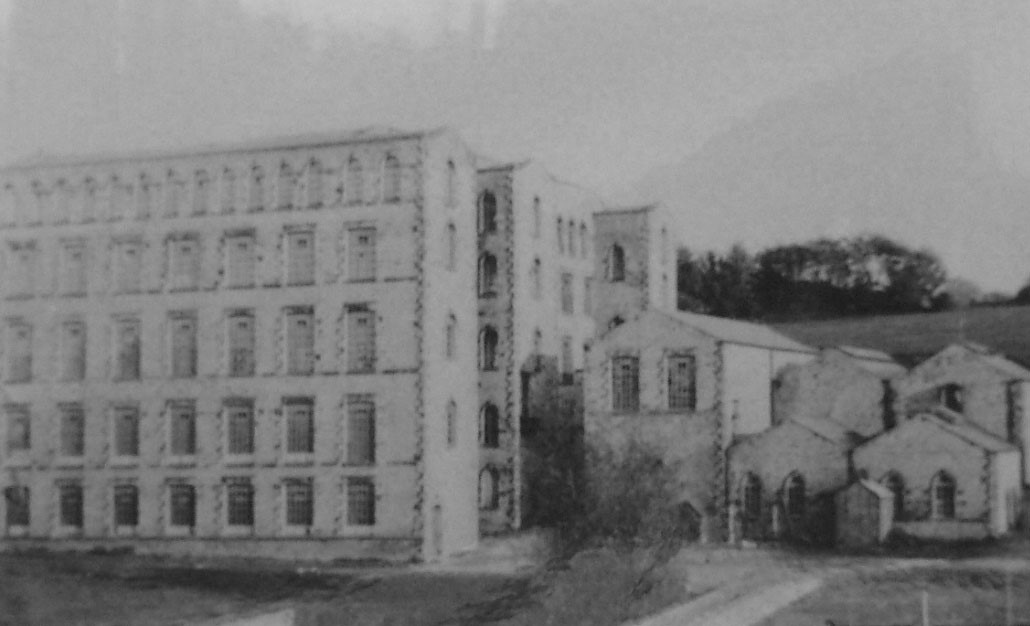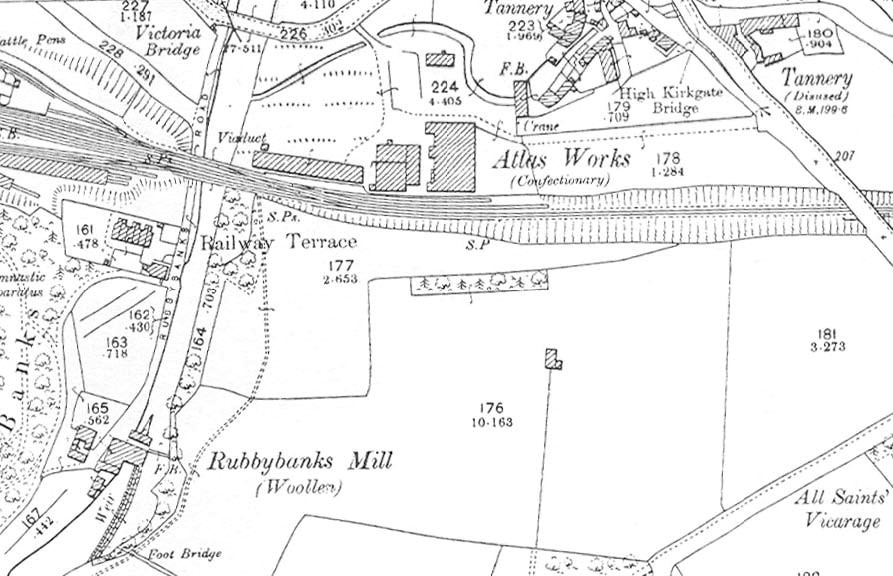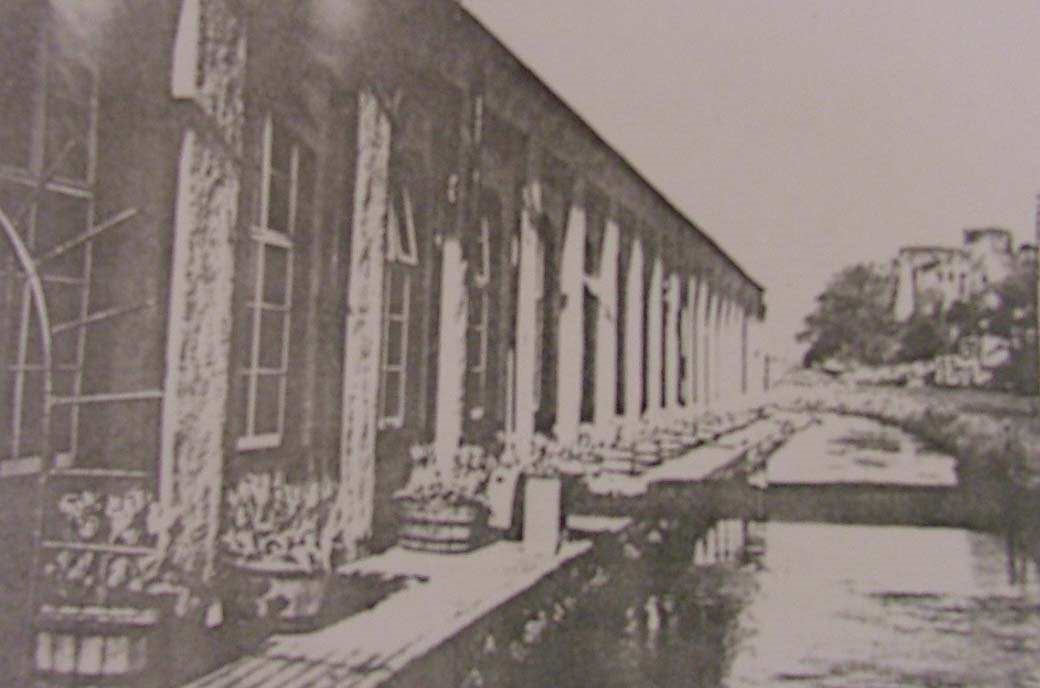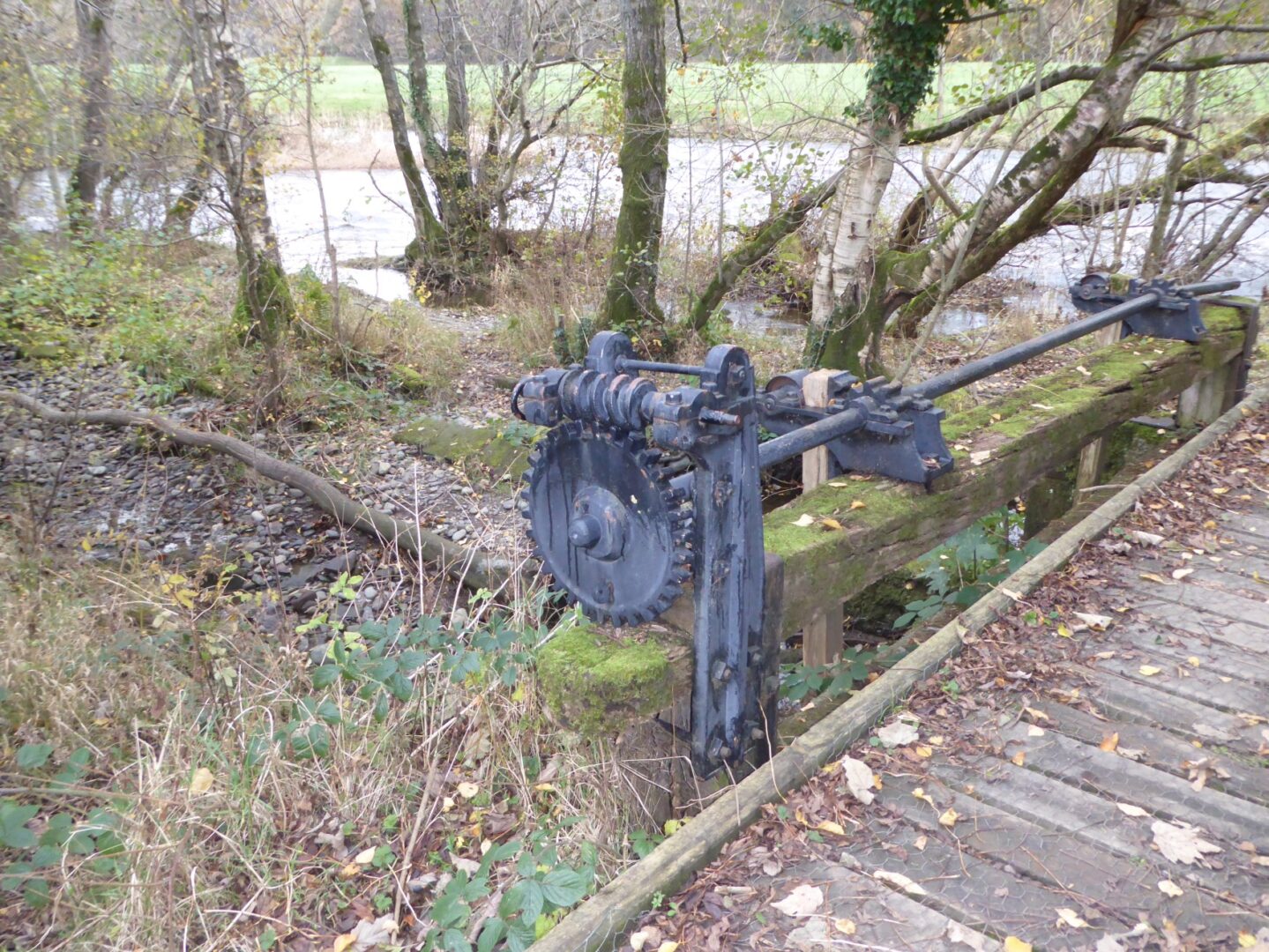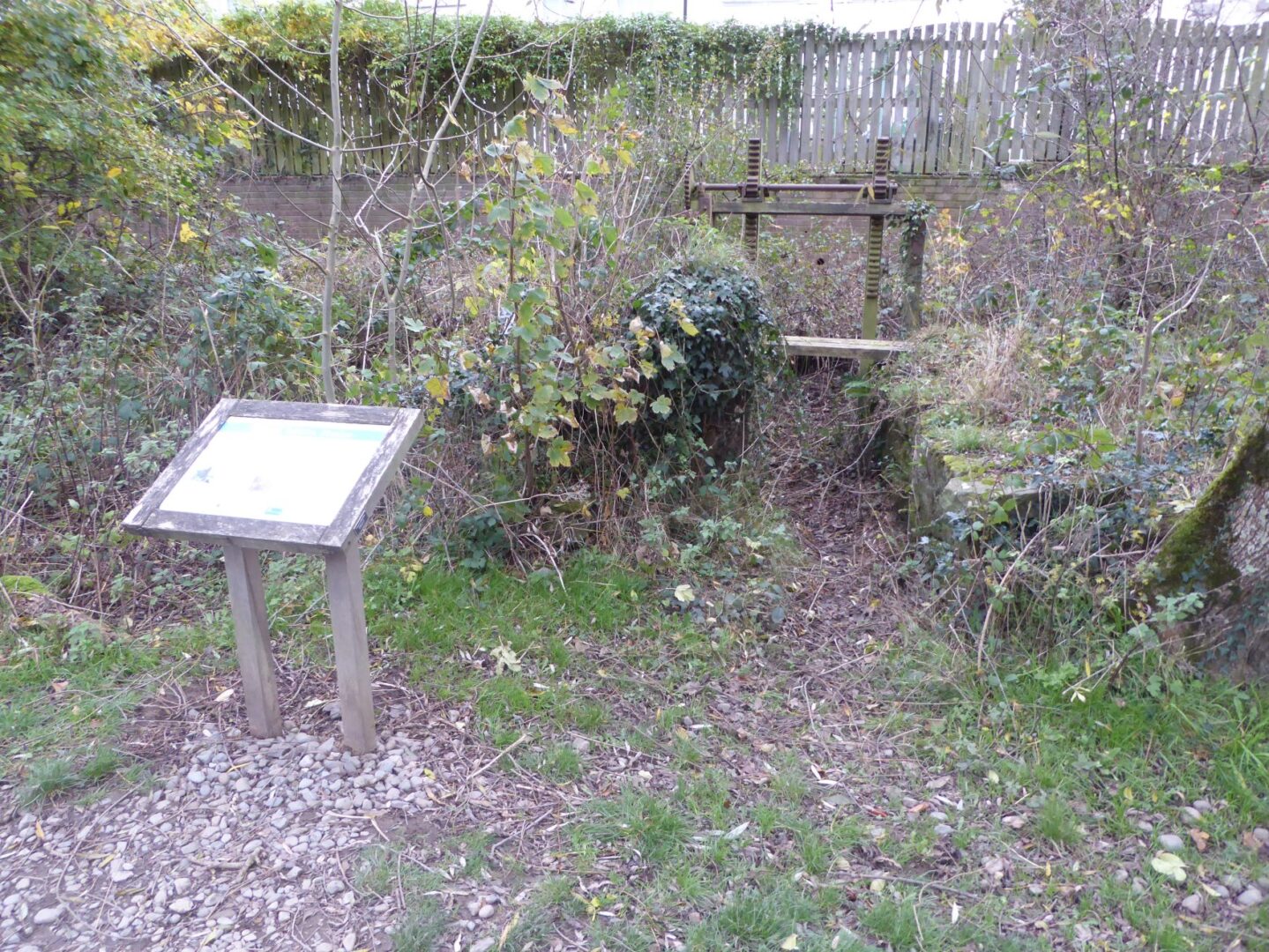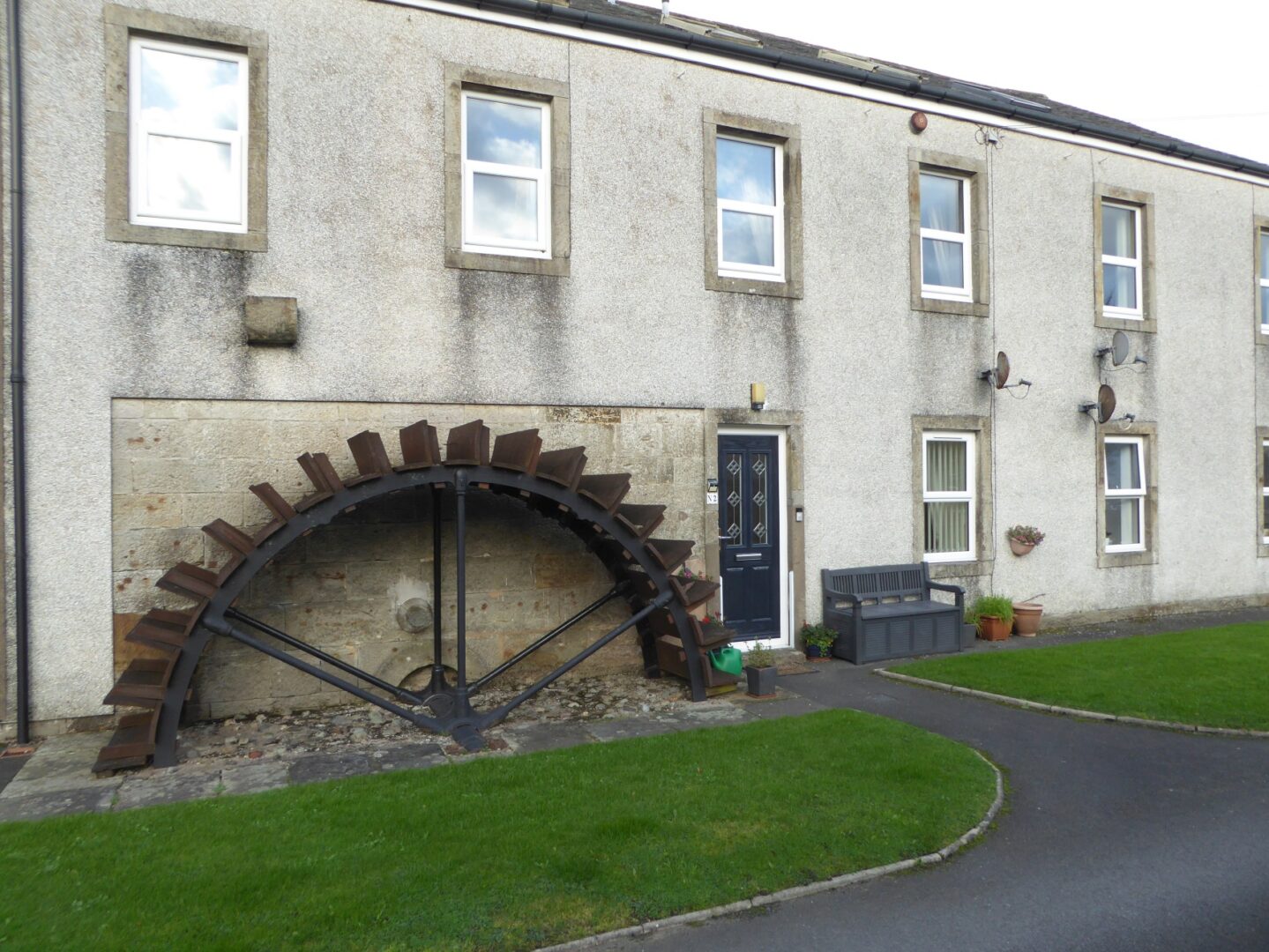Watermills of Cockermouth
(Click image to zoom)
Introduction
A watermill is a structure utilising a waterwheel to drive an industrial process such as grinding grain or textile production. It was one of the earliest forms of mechanical power and remained commonplace well into the 19th century.
The majority of early mills were used to grind corn using millstones powered by a water-driven wheel. Most Romano-British watermills were probably used for milling corn, as were examples from the medieval period, but from around the 12th century they were used for small-scale industrial purposes, mainly for iron-working, bark crushing (for tanneries producing leather) and fulling cloth. Fulling mills were where woollen cloth was beaten by hammers to strengthen the material, a process which had previously been undertaken by workers ‘walking’ on the cloth in containers, hence the surname ‘Walker’.
Archaeological excavations in 2010 to the west of Cockermouth, on the south bank of the River Derwent, revealed evidence of a Romano-British watermill dating to the 2nd century AD, indicating the use and importance of water power in the area around the town for nearly 2000 years. The site is one of only a handful known to exist from the Roman period in Britain.
When industry developed in the 18th century many heavy tasks were assisted by water power and early factories had to be located close to a source of water. Forge hammers, textile mills, paper mills, snuff mills, gunpowder mills and saw mills all made use of water power.
Most of the early watermills in the British Isles worked on a very simple principle: the waterwheel was placed horizontally and water, fed from a wooden channel, turned the wheel which drove the grinding stones above, also positioned horizontally. This type of waterwheel, often known as the ‘Norse’, ‘Greek’ or ‘Highland’ mill, was used by the Anglo-Saxons. Reconstructed examples can be seen in the far north of Scotland at Dounby in Orkney and at Shawbost on the Isle of Lewis.
Vertical waterwheels worked in the following way: water was delivered to the paddles or buckets on the wheel via a sluice gate. When the water fell onto a paddle or into a bucket its weight caused the wheel to move downwards. As the wheel rotated, another paddle or bucket came into contact with the water flowing through the sluice gate. As long as water flowed, the wheel continued to turn driving the machinery located within the mill buildings.
There are four kinds of vertical waterwheel: a Breastshot wheel has the water delivered at or above the centre point; an Undershot wheel has the water source below the centre; an Overshot wheel receives the power from above; and a Pitchback wheel has a high delivery point but turns in the same direction as a breastshot and an undershot.
An adequate supply of water was essential for every mill and sometimes it was necessary to bring a supply of water a considerable distance to a particular mill. The location of the mill itself was also important. On some fast-flowing rivers, particularly in flood, it would not have been possible to have a mill. At Cockermouth for example, a long ‘goyt’ or ‘leat’ (an artificial channel) was diverted from the River Derwent to reduce the flow of the water and allow it to be controlled. Some of these mill leats served more than one mill, as at the Goat (or Gote) area of the town. A common arrangement was the location of a waterwheel below a mill pond where water was stored and then released by sluice gates to power the wheel as and when it was required.
Some mills had more than one waterwheel. This was often the case when mechanical processes changed so much that it was easier to install another waterwheel rather than take out old workings and rebuild. This often happened in corn mills as wheat became more popular as a grain in the mid-18th century, with wheat mill machinery being installed to work from a second wheel. An example of the use of two waterwheels can be seen at Double Mills to the south of the town.
There are some characteristics of standing mill buildings which may provide a clue as to their use, although it must be noted that many mills changed functions, for example from corn grinding to woollen manufacture, as the market demanded.
Corn mills can be difficult to identify, as it has been suggested that ‘no two corn mills were ever exactly alike’. Many large corn mills were rebuilt during the early 19th century, shortly after the main period of field enclosures was completed around 1825. They are to be found in the richer farming lowlands of Cumbria and are fine structures of red sandstone, brick or white limestone. Generally the mill building itself will have been three storeys in height, with a corn-drying kiln to one end. The waterwheels were often located to the rear of the building, away from the site entrance, and often covered by a ‘lean-to’ to prevent damage to the wheel on frosty nights. Some corn mills may have had a projecting lucam; a wooden roof cover protecting an external sack hoist, as at High Gote Mill.
Cotton and flax mills (from around the middle of the 18th century) were generally tall buildings of four or five storeys with rows of windows on each floor. Woollen carding mills were similar to cotton mills in general appearance, although they were normally of three floors, for example Stoddart’s early 19th-century mill on the River Cocker. Bobbin mills were, almost without exception, two-storey buildings with rows of windows always on the upper floor and sometimes on the lower floor. The main building would have had a series of drying sheds close by, usually pillared on one side to allow air to flow freely through the stored timber.
Few watermills that stand in north Cumbria today were built before 1725. Early mills would have long since been enlarged several times over if they had not actually changed their usage and appearance altogether. Paper mills from around 1640 and fulling mills from earlier times have not survived at all. Few of the early cotton mills (from around 1750) and woollen mills (from around 1790) that were situated in very isolated places survived. Larger and better placed mills were added to and rebuilt.
One of the main features of the town of Cockermouth are the two rivers on which it stands, the Rivers Derwent and Cocker. Both of these watercourses provide an attractive place for a settlement. Not only did the junction of these two rivers form an effective barrier from possible enemies, but the flow of water provided an abundant source of power and supply.
Writing with regard to the confluence of the two rivers at Cockermouth in 1582, William Camden noted in his Britannia:
‘which when they meete doe incompasse, almost round about, Cockarmouth a mercate town of good welth, and a castle of the Earles of Northumberland. The town is built fair enough, but standeth somewhat with the lowest betweene two hills; upon the one of which the Church is seated and upon the other right over against it, a very strong castle’.
Cockermouth Castle was originally of the motte and bailey type built around 1150. It was replaced by a stone triangular version around 1225 and some parts of this early fortification can still be seen in the buildings that stand today.
The exact date of the foundations of the town is unclear, but historical documents appear to suggest that there was an urban community by the start of the 13th century.
There are references in a survey of the borough of Cockermouth taken around 1270 to two water corn mills, a fulling mill and a dye works. The presence of a fulling mill and a dye works in this period suggests that there was an important woollen industry based on the sheep farming of the surrounding hillsides and pastures. It is not clear where these early watermill sites were, but there is every possibility that they were situated very close to mills which continued into the 19th century. Double Mills, Wood (or Badgkin) Mill, Little Mill and one of the mills at the Goat (or Gote) area of the town all appear to have been in existence in the medieval period.
Documents dating to the 16th century have suggested that the following mills were then in existence:
Rubbybanks Mill was described in 1596 as a ‘water corn mill, late in the tenure of Richard Bacon’, which identifies it with the ‘New Mill lately erected at Casbay’ held by Bacon in 1578. It is likely that the rent of a ‘new’ mill entered into the manorial accounts for 1541, but not referred to in 1520, may also refer to this mill site and gives an approximate date for its foundation of between the two dates.
Little Mill is probably the water corn mill described in 1578 as ‘lying on the waste’ near Long Croft and formerly being a fulling mill. As such it can be traced back to 1437/8, and it may be the site of the fulling mill recorded in 13th-century documents.
Wood Mill (or Badgkin Mill) is probably to be identified with the fulling mill at Moor Closes listed in a survey of 1578. This mill can be traced back to the 15th century, as in 1453 it is recorded as ‘a new fulling mill on the Cocker’, and in 1478 it was described as ‘newly situated opposite the corn mill’. Its absence from accounts of 1437/8 suggests it originated between 1439 and 1453.
Double Mills lies on the Cocker, opposite the site of Wood Mill. As Wood Mill was noted to have been situated opposite the corn mill in 1478, Double Mills is therefore identified as the town’s 15th century corn mill, and may even date back as far as the 13th century.
Writing at the end of the 17th century, Thomas Denton noted that there were ‘two water-corn-mills’ in the borough of Cockermouth, although he does not specify exactly where they were.
By the end of the 18th century, the town was noted for its manufacture of ‘shalloons, worsted stockings and hats’, and there was also a ‘paper manufactory’ which is likely to have been a reference to Simonscales Mill situated to the south of the town. Jollie’s Cumberland Guide and Directory of 1811 is more specific, and actually names some of the mill owners:
‘The only late improvements made in this town worthy of notice is a handsome range of buildings, on the banks of the Cocker, a little above the bridge, the property of Messrs. Stoddart and Son, where an extensive linen-manufactory is carried on. There is also a large thread and cotton manufactory called the Goat Mills, the property of, and carried on by, Mr Wm. Fletcher. There is also an extensive manufactory of hats, and another of coarse woollen cloths and shalloons; likewise a pretty considerable trade in the tanning and dressing of leather. About a mile up the Cocker, is a paper mill’.
This description appears to indicate that Stoddart’s Mill, which was situated on the east bank of the River Cocker and now forms part of the buildings of Jenning’s Brewery, had been erected not long before 1811. The building which stands on the site today has a date stone of 1800 in its south gable, which may tie in with this description.
In 1829 the main industries of Cockermouth were described as the manufacture of ‘cotton checks, ginghams, coarse woollen goods, linen and linen thread, hats, paper etc; and in the tanning and dressing of leather’. Wm and Jonathan Harris at Goat Mills and William Stoddart at Cocker Bridge End were cotton, check and gingham manufacturers.
Joseph Grave, woollen manufacturer and Joshua Wharton, flax and tow spinners were listed on Sand Lane (Waterloo Street), with Wm and Jonathan Harris at Goat Mills and Thomas Robinson at Cocker Bridge End. The main corn mill sites at this date were Double Mills, Gote, ‘Raby Banks’ (Rubbybanks) and ‘near Kirkgate’ (possibly referring to Little Mill).
Flax and hemp in Cockermouth mills
Flax, along with hemp, was grown in the northwest of Britain for centuries, although it was also imported from Baltic ports. In the area around Lancaster at the start of the 19th century hemp was being used for the production of sailcloth and cordage, whilst flax was used in the manufacture of linen and linen thread. Before the growing of cotton became widespread in the United States, flax was the world’s most important raw material in the manufacture of textiles. Flax is a delicate plant with long narrow leaves and pale blue flowers. The best soil for growing flax is a heavy, rich, well-drained loam. The fibres vary in length, overlap each other and are held together by a gummy matter. After harvesting, the plants were subjected to coarse combing to remove the seed pods. They were then ‘retted’; a process which involved lying the plant outside so that it was subjected to the action of the weather and micro-organisms to separate the fibres from the woody parts of the stems. The last process is ‘hackling’, whereby the flax is combed and the short fibres, known as ‘tow’, are removed from the long fibres known as ‘stricks’. The flax fibres were then ready for spinning as would have been undertaken by the workers of Joshua Wharton and the Harris brothers.
There was a considerable variety of organisation in the early 19th century flax industry. The large concerns controlled the whole process of manufacture, but some mill spinners specifically set out to serve the linen manufacturers who lacked their own spinning facilities. In 1810 William Fletcher announced in a local paper that he had
‘lately purchased and entered upon the Goat Mills near Cockermouth (late Mowbray & Co.) where he proposes to carry on the spinning of flax and tow for hire; and hereby solicits the Patronage and Encouragement of Linen Manufacturers and Others, who are in the habit of putting out flax and tow to spin’.
Rubbybanks Mill, by the River Cocker, installed one of Richard Arkwright’s famous water frames in 1781 in order to manufacture cotton thread. The water frame, so called because water was used to power it, was a mechanised way of spinning yarn into thread. This speeded up the process compared to hand spinning, enabling the move away from small scale home manufacturing towards factory production.
Some of the mills in Cockermouth used steam power to drive their machinery and in some cases, such as at Fitz Mill, both steam and water power appear to have been used. Derwent Mills utilised steam power from the start and did not use the mill race that it was constructed beside to drive its machinery, but probably did use the water for its boilers and for humidity in the weaving sheds. Tweed Mill also only used steam power and is the only mill in Cockermouth not located alongside a watercourse.
Derwent Mills (Harris Mill)
Derwent Mills is located to the north of the town on the north side of the River Derwent. The first phase of the mills was constructed in 1834 with considerable extension in 1847 and 1855. The mills were erected by the Harris family who had begun linen manufacture in Cockermouth at Low Gote Mills in the early 19th century. Derwent Mills was constructed on open ground to the southeast of Low Gote Mills to accommodate their expanding business. John Wood’s ‘Plan of the River Derwent and Goat Mill Race’ dated 1832, shows the land on which Derwent Mills would later be constructed as open fields owned by Mr Joseph Steel (apart from the course of the mill race which supplied the watermills at the Goat).
Harris embroidery thread was the very first range of coloured thread and was produced in over 200 different shades. The firm also wove linen and at times employed up to 800 people. Bolton’s book of 1912 carries an advertisement for ‘Harris Linen, Harris Flax and Silk Cloth, Harris Cumbrian Embroidery Silks, Harris Flax Embroidery Thread and Harris Art Embroideries’.
An advertisement of 1905 for Messrs. Jonathan Harris and Sons, Ltd. shows the extensive buildings beside the River Derwent, with the Goat Mill Race running alongside a single-storey building. At this time, the firm advertised their specialities as ‘Flax Embroidery Threads and Art Linens for Domestic and Ecclesiastical use’.
Mate’s Illustrated Guide to Cockermouth, published c.1905, noted:
‘Visitors to Cockermouth should inspect the Art Embroidery Show Rooms at Jno. Harris and Sons, Ltd., Derwent Mills. Admission is free to Showrooms. Visitors can be shown through the Flax Spinning and Weaving Mill at a charge f 6d. each [2½p]. Specimens of the beautiful embroidery made in the workrooms may be seen and purchased. Nobody should omit this item on a visit to the town’.
The firm closed following the depression of the early 1930s and in 1934 a new company, Jonathan Harris and Sons, (Cockermouth) Ltd., was formed to manufacture linen in part of the mill and the thread business was sold to Henry Campbell and Co. of Belfast.
At the start of World War II the premises were in use again when Millers (Great Yarmouth) Ltd. brought their footwear machinery and approximately 200 employees from the Norfolk coast. This migration became permanent with the firm employing 1100 workers in the Cockermouth factory and in the branches it opened in Workington, Frizington and Egremont. Around 40,000 pairs of sandals, boots and ladies and children’s shoes were produced each week, supplying many of the well known retailers. Millers Ltd. continued production here until the early 1990s.
Graves’s Woollen Mill and Wharton’s Woollen Mill
On the north side of Waterloo Street, where modernised housing now stands, was Graves’s Woollen Mill which dated to the 1820s. Graves’s building had a feature which was common in Cockermouth’s industrial buildings of this date; a small pointed window high in the gable end. A window of this style can still be seen in the ‘hospice’ at Spittle Ing. Other examples existed in Croft Mill prior to its conversion to flats. Further along Waterloo Street stood Wharton’s Woollen Mill also dating to the 1820s. Both Wharton’s and Graves’s Mills were powered by waterwheels located in a mill race, partially culverted, which ran along the bank of the River Derwent.
Stoddart’s Mill
What survives of Stoddart’s Mill buildings, located on the east bank of the River Cocker below Cocker Bridge, now forms part of the Jenning’s Brewery site. The building bears the inscription ‘J & M S 1800’ in its south wall, and may be one of those buildings referred to in Jollie’s Cumberland Guide and Directory of 1811. In 1829 a William Stoddart is listed as a ‘cotton manufacturer (check and gingham)’ at Cocker Bridge End.
Croft Mill and Cocker Bridge (End) Mill
On the west bank of the River Cocker opposite the Town Hall stood Croft Mill. The building along the riverside was constructed in the middle of the 19th century as a woollen mill and was used for textile manufacture for most of its existence, occasionally being used for making hats. Croft Mill was converted into flats around 1970 and is now known as ‘Hatters Croft’. To the north of Croft Mill was another woollen mill, Cocker Bridge (End) Mill which originally extended to Main Street. This was certainly in existence in 1829 when Richard Smith is listed in a trade directory as a woollen manufacturer. Cocker Bridge (End) Mill appears to have been demolished by 1900 as it is not shown on historical mapping of that date.
Sanderson’s Mill
The site of the present Town Hall, originally constructed as a Methodist Chapel in 1841, is the former location of Sanderson’s Woollen Mill, which was in existence before 1832 when it is shown on a plan of the town. Very little appears to be known about the mill which was demolished before 1841 when the Methodist Chapel was built. The site now survives as the Riverside Car Park. The present Bitter Beck Car Park was the drying grounds for the mill and on the terrace to the west below the churchyard stood a row of ten cottages, Mount Pleasant. Dilapidated buildings and sheds covered this area until it was cleaned and landscaped by the Urban District Council in the 1970s. The section of stone wall containing three arches was rebuilt following the 2009 floods and provides access to the area to south of the Town Hall.
Little Mill
Little Mill, located on the south side of Tom Rudd Beck, may be one of the earliest watermill sites in Cockermouth. It may have been the corn mill which is referred to in a pre-1215 charter of Alice de Rumelli, and the fulling mill of the Minister’s Accounts of 1437/8. In a survey of 1578 it was described as ‘corn mill on the Lord’s waste near Long Croft’, Long Croft being the old name for Windmill Lane.
As with many watermills, Little Mill was converted to a different use in 1763 when it was leased to a tanner for grinding bark. Old maps of Cockermouth show two tanneries located on the opposite side of Tom Rudd Beck for which the bark may have been ground. Little Mill continued to be used for grinding bark until it was taken over around 1810 and rebuilt as a corn mill along with a house and outbuildings.
On John Wood’s ‘Plan of Cockermouth’ dated 1832, the mill is labelled as a corn mill, but by 1900 it is shown as ‘Disused’, like so many other corn mills around this date. Little Mill is now a private dwelling having been used as a saw mill later on in the 20th century.
Tweed Mill
Tweed Mill was a steam-powered mill constructed in 1872-74 for the manufacture of tweed. It contained the latest equipment for lighting, heating and machine power, and had a 120ft high chimney which became a local landmark. The ground floor was a warehouse and above it were the fulling, scouring and drying machines, a hydraulic press, carding and twisting rooms, with 40 looms in the weaving room on the top floor producing rugs and blankets including imitations of leopard and tiger skins.
Despite this, the mill was not a success and employees were being dismissed by 1877 with it being sold in 1883 to William Brown and Company of Selkirk. At its peak the mill employed between 300 and 400 workers.
By 1897 the premises were known as the Atlas Works and were occupied by A and H Rea, manufacturing confectionary. In 1913 the buildings were used for the manufacturing of cycle cars under the management of J A Forrester, son of a local coachbuilder.
There was a growing demand for these small three and four-wheeled cars with motor cycle features. An article of 1913 commented:
‘Far away in the little town of Cockermouth, an old tweed mill has been converted into an upto-date cycle-car manufacturing works’.
This new industry also appears to have been unsuccessful, possibly due to the outbreak of World War I, and in 1918 the mill was demolished leaving only a few outbuildings later to be used by various local companies.
Rubbybanks Mill
There is a record of Ribbey Banck Milnes being leased by the Earl of Northumberland to Thomas Fletcher, a Cockermouth merchant, in 1596. When Thomas Dodgson leased the site in 1714 he erected a new corn mill, two mills then stood on the site making it difficult to distinguish between them in historical documents. The mill buildings which stood on the site until 1971 are believed to have dated to the 18th century and have variously been used as fulling mills, corn mills, flax mills and for the manufacture of cotton thread.
A change in the function of a mill was common. If the demand for a product fell, a mill tenant would probably have looked for something more profitable to make. If it was seen that a new product prospered then other mill owners in the town would tend to follow suit.
In 1893 half of the Rubbybanks complex was leased to George Tinker, manufacturer of coverings, skirting and collar checks, tweeds, blankets and rugs. He would make up customer’s own wool or produce rag carpeting from their own rags. Although he had left the mill in 1920, at the time of demolition it was still referred to as ‘Tinker’s Mill’.
From 1920 the mill site was worked by Joseph Messenger who worked as a wood turner, cooper and pattern maker. He was followed by another wood turner, who produced items such as hay rakes and stools. From 1963 the buildings were used for a short time by a timber merchant.
The last of the mill buildings were demolished in 1971 as they were unused and in a dangerous condition. The two mills had parallel wheel pits, one of which still contained its wheel when it was demolished.

Double Mills
Double Mills was probably constructed in the early 19th century, although it is believed that there was a water corn mill on the site in the 15th century and may even have been as early as the 13th century.
For most of its life Double Mills appears to have operated as a corn mill and by 1900 it is marked on maps as ‘Disused’. A few years later the Urban District Council bought the building with the intention of using it either as an isolation hospital, to obtain electricity by water power or as the basis for a recreation ground.
None of these plans materialised and it was leased to the Youth Hostels Associations (YHA), opening in 1933 and still in use as a Youth Hostel today. [nb the text from the original publication is from 2012, the mill is now privately owned. PN]
The building which stands had two waterwheels in parallel races. Each could be operated independently and were powered by water diverted from the River Cocker. Two large French Burr stones which stand against the bank by the mill were used in the mill for splitting open and shelling the grain being ground from the husks. The hard sections of French Burr were bound together with iron hoops, and sections of these heavy millstones can often be found on or around mill sites.
Wood Mill (Badgkin Mill)
Wood Mill was a fulling mill located on the opposite side of the river to Double Mills. Fulling was the process where woollen cloth was placed in troughs of soapy water and was then ‘walked on’ with bare feet giving the cloth thickness and body. This process became mechanised with water-powered hammers used to pound the cloth.
In a document dated 1830 reference is made to ‘All that fulling and spinning mill and premises at Badgkin in a certain close called Leather Mill Field but formerly known by the name of Badgkins Close which said premises were lately occupied by Mrs Beeby and used by her as a spinning and carding mill’. A further document of 1882 refers to it as ‘a Leather Mill’.
Following this date the mill appears to have been used as a saw mill and forge for making iron tools. In 1863 the site is marked as ‘Wood Mill (Bobbin)’, indicating that it had been used for fulling, leather works, spinning and carding, wood sawing and tool making and bobbin manufacture.
Wood Mill is not shown on historic maps dating from 1900 which suggests that it had been demolished by then. All that can be seen of the mill today are the remains of some stone walls and a watercourse cut into the rock which can be seen from the footbridge which crosses the River Cocker at this point.
Fitz Mill
Until 1935, when boundaries were redrawn, the Goat was part of the township of Papcastle with Gote Mills being Papacastle’s manorial mill. Although Fitz Mill was technically in the township of Brigham inhabitants of the Goat would have found work in the Fitz Mill complex as well as in the Gote Mills. Fitz Mill was located on the west bank of the River Derwent where the river takes a sharp bend to the north of the Goat.
There has been a mill on this site since at least the late 18th century, and the mill that was standing until around 1980 is believed to have been erected in 1794 as a flax mill. The Goat (or Gote) was an isolated community separated from the town by fields in which flax was retted. This mill is also marked as ‘Disused’ on maps of 1900, a section of wall and some foundations are all that remain.
Low Gote Mills
Low Goat Mills comprised two mills, the lower one has been demolished and the upper one has been converted to housing. The restored waterwheel of the upper mill remains at the property. It is possible that a mill was in this location in the 16th century when Elizabeth I granted permission for the mill race to be doubled in width. The mill race, which powered all the Goat Mills, was certainly in existence by 1700.
A mill was built here for grinding corn in 1609, being rebuilt for textiles in 1779 before reverting back to grinding corn in 1858. The two mills were probably of different dates. A map dated 1727 labels them ‘Logwood Mill. Wheat Mill. Corn Mill’. Another map of 1832 shows them both as flax mills, the upper one belonging to Thomas Mawson and the lower to Jonathan Harris who was on the site until 1847. By 1863 these two mills, along with High Gote Mill across the road, are marked as ‘Goat Mills (corn)’.
High Gote Mill
High Goat Mill generally operated as a corn mill, although it has at times been used as a textile mill. The Harkness family were millers of flour and grain, roasters of barley for brewing, and suppliers of feeding stuffs for cattle, sheep, pigs and poultry. The mill was worked until 1969 with the main building now occupied by Lawson’s Haulage Ltd. High Gote Mill spanned the mill race. The race emerged between the building and the wall and passed under the road towards Low Goat Mills where it rejoined the River Derwent.
Suggested further reading:
A History of Linen in the North West, Edited by Elizabeth Roberts, 1998. Bradbury’s History of Cockermouth, J. B. Bradbury, 1995. Watermills and How They Work, John Vince, 1993. Watermills of Cumbria, Mike Davies-Shiel, 1978.
Thanks are extended to Cockermouth Town Council for their support and correspondence in the preparation of this booklet.
Gote Mill Race Track
The footpath from the car park / footbridge by Derwent Mill follows the mill race for Gote Mills. The channel of the mill race has been covered over where it borders the factory at the bottom of Gote Brow. A huge concrete walled cylindrical tank was lowered into the ground at the bottom of the Gote after the floods in Cockermouth. (another two are buried under Main Street to try to catch the flood overflow to High Sands Lane). The outflow of this mill race can be seen with some difficulty by going into the cricket ground, through the entrance on the left to the bank of the Derwent, continue past the fishing hut, beware of undergrowth and the remains of the old municipal tip beside the river (!!) and you will just manage to see the huge blocks of stone where the mill race is likely to have entered the Derwent.
